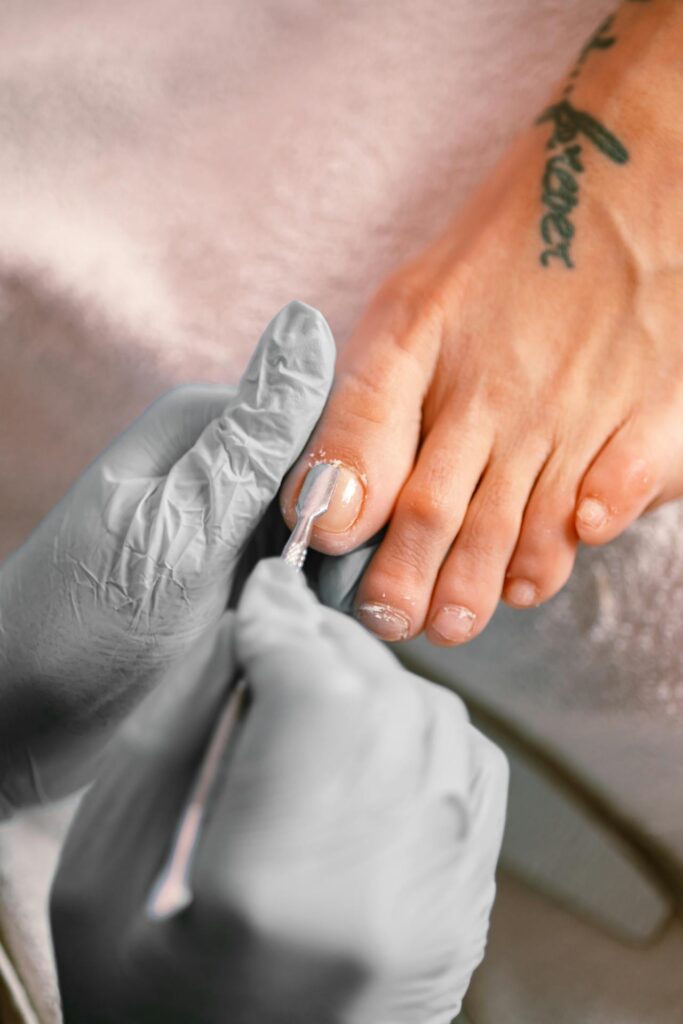Ingrown toenails can be a painful and frustrating condition to deal with. They occur when the edge of the toenail grows into the surrounding skin, causing redness, swelling, and discomfort. While it is always best to seek professional medical advice for severe cases, there are several effective home remedies that can help alleviate the symptoms and promote healing.
One of the most common home remedies for ingrown toenails is soaking the affected foot in warm water. This helps to soften the skin and reduce inflammation. To do this, fill a basin or tub with warm water and add a tablespoon of Epsom salt. Soak your foot for 15-20 minutes, twice a day. After soaking, gently dry the area and apply an over-the-counter antibiotic ointment to prevent infection.
Another effective home remedy is to gently lift the ingrown toenail using a small piece of cotton or dental floss. This helps to separate the nail from the skin and encourages it to grow in the right direction. To do this, carefully slide the cotton or floss under the edge of the ingrown nail. Be sure not to force it or push it too far, as this can cause further damage. Leave the cotton or floss in place until the nail grows out and the pain subsides.
Applying a topical antibiotic cream or ointment can also help to prevent infection and promote healing. Look for products that contain ingredients like neomycin or bacitracin. Apply a thin layer to the affected area after soaking and drying your foot. Be sure to follow the instructions on the packaging and consult a healthcare professional if you have any concerns.
Wearing properly fitting shoes is crucial when dealing with ingrown toenails. Tight or narrow shoes can put pressure on the toes and exacerbate the condition. Opt for shoes with a wide toe box that allow your toes to move freely. Avoid high heels or shoes with pointed toes, as these can increase the risk of ingrown toenails. If necessary, consider wearing open-toed shoes or sandals until the condition improves.
Maintaining good foot hygiene is essential for preventing and treating ingrown toenails. Keep your feet clean and dry, paying special attention to the affected area. Trim your toenails straight across, avoiding rounded edges that can encourage ingrown nails. Use a clean and sharp nail clipper, and be careful not to cut the nails too short. If you have difficulty trimming your nails, consider seeking professional help from a podiatrist.
In some cases, ingrown toenails may require medical intervention. If home remedies do not provide relief or if the condition worsens, it is important to consult a healthcare professional. They may recommend a minor surgical procedure to remove the ingrown portion of the nail or prescribe antibiotics to treat an infection.
In conclusion, while ingrown toenails can be painful and bothersome, there are several effective home remedies that can help alleviate the symptoms and promote healing. Soaking the foot in warm water, gently lifting the ingrown nail, applying topical antibiotic creams, wearing properly fitting shoes, and maintaining good foot hygiene are all proven ways to deal with ingrown toenails. However, it is important to seek professional medical advice if the condition persists or worsens.
Professional Treatment Options for Ingrown Toenails

Ingrown toenails can be a painful and frustrating condition to deal with. If left untreated, they can lead to infection and further complications. While there are several home remedies that can provide temporary relief, sometimes professional treatment is necessary to effectively deal with ingrown toenails.
One of the most common professional treatment options for ingrown toenails is a procedure called partial nail avulsion. This procedure involves removing a portion of the affected toenail to relieve the pressure and allow the nail to grow properly. It is typically performed under local anesthesia, so you won’t feel any pain during the procedure. After the nail is removed, the area is cleaned and a dressing is applied to promote healing.
Another professional treatment option is total nail avulsion. This procedure involves removing the entire affected toenail. While it may sound extreme, total nail avulsion is often recommended for severe cases of ingrown toenails or for individuals who have recurrent ingrown toenails. Like partial nail avulsion, this procedure is performed under local anesthesia to ensure your comfort.
In some cases, a chemical cauterization procedure may be recommended. This procedure involves using a chemical solution to destroy the nail matrix, which is the area where the nail grows from. By destroying the nail matrix, the nail will no longer grow and cause ingrown toenails. Chemical cauterization is typically reserved for individuals who have chronic ingrown toenails that have not responded to other treatments.
Laser treatment is another professional option for dealing with ingrown toenails. This treatment involves using a laser to remove the affected portion of the nail and to destroy the nail matrix. Laser treatment is often preferred by individuals who are looking for a less invasive option compared to traditional surgical procedures. It is also known to have a shorter recovery time and less post-operative pain.
If you have an ingrown toenail that is infected, your healthcare provider may prescribe antibiotics to help clear the infection. Antibiotics can be taken orally or applied topically, depending on the severity of the infection. It is important to take the full course of antibiotics as prescribed to ensure that the infection is completely eradicated.
In addition to these professional treatment options, your healthcare provider may also recommend certain preventive measures to help prevent future ingrown toenails. These may include wearing properly fitting shoes, trimming your toenails straight across, and avoiding tight socks or stockings. Your healthcare provider may also provide you with specific instructions on how to care for your feet and nails to prevent ingrown toenails from recurring.
In conclusion, while there are several home remedies that can provide temporary relief for ingrown toenails, professional treatment options are often necessary for long-term management. Partial or total nail avulsion, chemical cauterization, laser treatment, and antibiotics are all effective ways to deal with ingrown toenails. Additionally, preventive measures can help reduce the risk of future ingrown toenails. If you are suffering from ingrown toenails, it is important to consult with a healthcare professional to determine the best course of treatment for your specific situation.
Preventive Measures to Avoid Ingrown Toenails
Ingrown toenails can be a painful and frustrating condition that many people experience at some point in their lives. They occur when the edge of the toenail grows into the surrounding skin, causing redness, swelling, and discomfort. While there are various treatment options available, it is always better to prevent ingrown toenails from occurring in the first place. In this article, we will discuss some proven ways to deal with ingrown toenails through preventive measures.
One of the most effective ways to prevent ingrown toenails is to trim your nails properly. It is important to cut your nails straight across, rather than rounding the edges. This helps to ensure that the nail does not grow into the skin. Additionally, it is recommended to keep your nails at a moderate length, neither too short nor too long. Short nails are more prone to becoming ingrown, while long nails can easily get caught on things and become damaged.
Wearing proper footwear is another crucial preventive measure. Shoes that are too tight or narrow can put pressure on the toes, causing the nails to grow into the skin. It is important to choose shoes that provide enough room for your toes to move freely. Avoiding high heels and pointy-toed shoes can also help reduce the risk of ingrown toenails. Opt for shoes with a wider toe box and good arch support to promote healthy foot mechanics.
Maintaining good foot hygiene is essential in preventing ingrown toenails. Regularly washing your feet and keeping them clean and dry can help prevent infections that can worsen the condition. It is also important to avoid picking or tearing at the skin around the nails, as this can lead to ingrown toenails. If you notice any signs of infection, such as increased redness, swelling, or discharge, it is important to seek medical attention promptly.
For individuals who are prone to ingrown toenails, there are additional preventive measures that can be taken. Soaking your feet in warm water with Epsom salts can help soften the skin and nails, making them easier to trim. After soaking, gently push back the cuticles and use a clean, sharp nail clipper to trim the nails straight across. Applying a moisturizer to the feet can also help keep the skin soft and prevent dryness and cracking.
In some cases, ingrown toenails may be caused by an underlying condition, such as fungal infections or nail abnormalities. If you have recurring ingrown toenails, it is advisable to consult a healthcare professional or a podiatrist. They can assess your condition and provide appropriate treatment options or recommendations.
In conclusion, preventing ingrown toenails is always better than dealing with the pain and discomfort they can cause. By following these proven preventive measures, such as proper nail trimming, wearing appropriate footwear, maintaining good foot hygiene, and seeking professional help when needed, you can significantly reduce the risk of developing ingrown toenails. Remember, taking care of your feet is essential for overall foot health and well-being.








